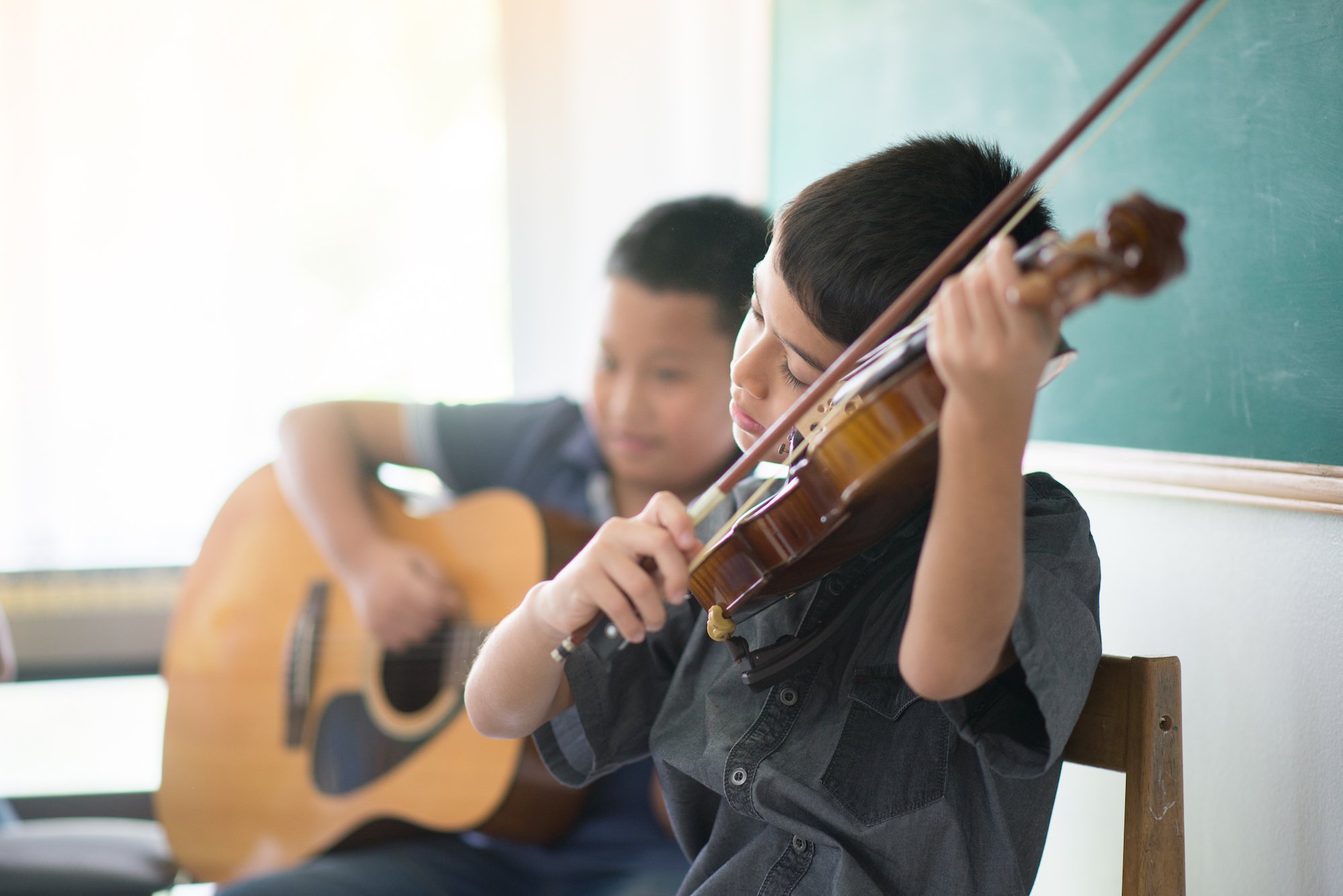Using Music to Inspire Boys

What captures young boys’ musical interests? How do boys learn that music-making is so rewarding? Why is “learning through play” so valuable and does every boy really sing?
Boys in my classroom learn quickly that the music classroom is a place to have fun. Musicianship is developed while building skills through singing, playing instruments, speech, and movement.
Boys want to FEEL the music in a physical way. From the youngest students on up, finding and dividing the beat has universal appeal. Right from my initial greeting, there is clear evidence of the beat. Strong rhythmic work is exciting, and motivating, and crosses into vocalizing, body percussion, movement, and instrumental patterns. A little syncopation can be catchy and a little bit “groovy” which is attractive to all participants.
Boys like to move. They have abundant energy and are going to move anyway, so why not make it productive! There are no chairs in my classroom and students happily sit on the floor. They won’t be there for long! Large muscle movement can be as simple as standing up and sitting down, or as complex as a multi-layered folk dance. Boys are often better at large muscle movement rather than small muscle movement. As such, movement is embedded firmly in the curriculum, and because my classroom is just boys, they hold hands without giving it a thought.
Body percussion is key to large muscle movement. Cadenced clapping, stepping, or finger snapping can be done by every student at any age. It is also an important step in the music-making process as boys ready themselves to transfer a pattern they have learned or created to an instrument. For boys who may be reluctant participants in music making, using their speaking voices musically and performing body percussion alone or with others makes for comfort and confidence in the classroom. Again, rhythm is key and since exact pitch is not needed here, boys who might feel insecure about their singing voices feel comfortable.
Boys like to hit stuff. That doesn’t mean body percussion or playing instruments should be perpetually loud or overbearing. Learning musicianship through dynamics is one of the easiest and immediately effective paths to artistry. Many boys’ natural inclination is to be loud. In my classroom, boys understand that loudness has its place. Yes, there is a time to play hard and loud and learn to build a crescendo. Boys need to learn not to harm their bodies or their classmates while doing group body percussion.
Gentle and beautiful doesn’t have to be feminine. Artful body percussion fosters focused listening, which transfers to the skillful and thoughtful playing of instruments. Respect for each other, for the music, and for taking care of the instruments are natural outgrowths of listening and responding to dynamics. One of my hard and fast classroom rules is: if you can’t feel the pattern and do it on your own body, you are not ready to play the instrument yet. Give a little more practice time, including vocalizing the pattern, then transfer to a xylophone or other percussion instrument. Creating anticipation by having the students practice the pattern a little longer often helps boys gain self-control and confidence.
What about singing? Boys sing naturally, joyfully, with energy and quality, but often not consistently. It’s OK if their singing voices aren’t perfect. I compare singing to math or spelling, in which nobody gets his work 100% correct, 100% of the time. With focused listening, lots of opportunities to hear oneself, fun warm-up vocalizing, singing games, beloved traditions repeated over years such as patriotic or seasonal songs, boys can and do sing very well. Guided listening, consistent effort, and energy turn into accuracy and quality over time.
A boy might be concerned if his voice is not “home” today. Sometimes it is hard to get started, especially if it’s early in the morning, or after a vacation break. If a boy’s singing voice is awkward or missing in the game or activity, it will be there another day. Oh well, no big deal!
Singing is not just for girls! I encourage boys to make the most of their singing voices in its soprano range and tell my older students they have this magnificent chance to sing brilliantly before their boy’s voice is gone forever as they turn into men. This is it, make the most of it!
Teamwork cannot be underestimated when corralling boys. Boys want to belong to a group and like to do things together. Boys bond through loyalty. As demonstrated by sports and other activities such as scouting, doing an activity together attaches boys to each other. Music-making in ensembles across grade levels offers opportunities for significant role modeling, coaching, and leadership. Socialization is a vital and necessary part of growing up.
Boys seek active engagement with others. They want and need to belong to something bigger than themselves and to be busy with affirming activities. Boys work with a partner or in small and large groups to problem-solve and find their own creative solutions. They desire security and familiarity, provided by the safe zone of the classroom. They very much like to compete and collaborate, will rise to a challenge, take a risk, and appreciate being noticed and encouraged.
My willingness to let boys take their time and find ways for them to be musically successful makes for a happy classroom. Who knows what will spring from such a joyful foundation?
Amanda Matthews teaches music to Junior Kindergarten to grade 4 at University School. Her curriculum is grounded in the Orff-Schulwerk model of music and movement education. Carl Orff and his partner Gunild Keetman, who developed the approach, believed that children learn best through whole body active engagement, regularly improvising and developing their creative and artistic potential. Learning through play is fun and games, but not without challenges, including reading and comprehending simple musical notation. Orff-Schulwerk is a social model in which students consciously cultivate cooperation, empathy, tolerance, and patience.


%202.jpeg)
